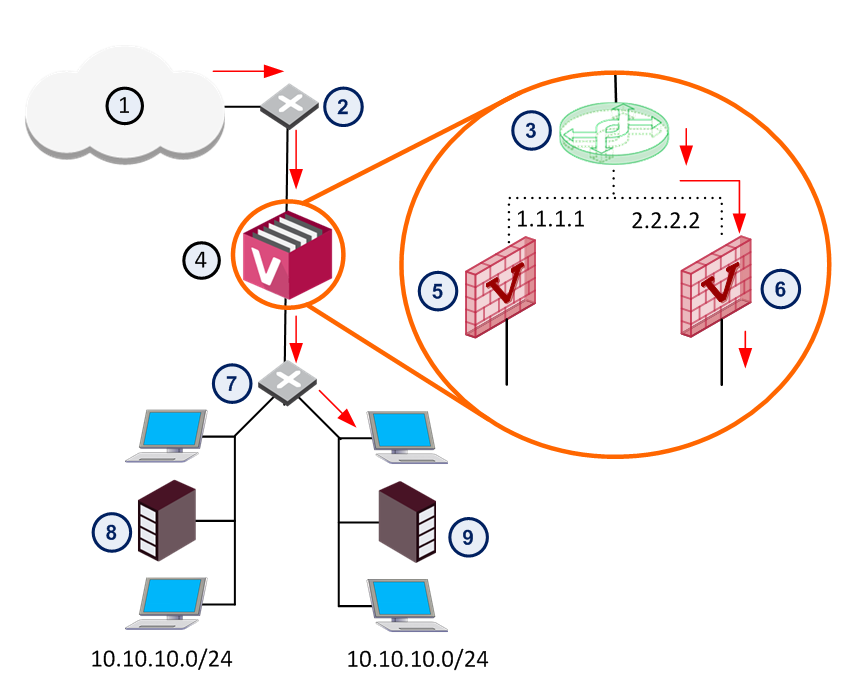


The traffic routing features in VSX network topologies are analogous to those available for physical networks. This section discusses several routing features and strategies as they apply to a VSX environment.
Virtual Routers and Virtual Switches can be used to send traffic between networks located behind Virtual Systems, much in the same way as their physical counterparts.
The figure below shows an example of how Virtual Systems, connected to a Virtual Switch and a physical VLAN switch, communicate with each other. In this example, a host in VLAN 100 sends data to a server located in VLAN 200.

Item |
Description |
|
Item |
Description |
|---|---|---|---|---|
1 |
VLAN 100 |
|
7 |
VLAN 200 |
2 |
VLAN Switch |
|
8 |
VSX Gateway |
3 |
VLAN Trunk |
|
|
VLAN Interface |
4 |
Virtual System 1 |
|
|
VLAN Trunk |
5 |
Virtual Switch |
|
|
Warp Link |
6 |
Virtual System 2 |
|
|
|
When a Virtual System is connected to a Virtual Router or to a Virtual Switch, you can choose to propagate its routing information to adjacent Virtual Devices. This feature enables network nodes located behind neighboring Virtual Systems to communicate without the need for manual configuration.
Route propagation works by automatically updating Virtual Device routing tables with routes leading to the appropriate Virtual Systems.
When Virtual Systems are connected to a Virtual Router, VSX propagates routes by automatically adding entries to the routing table contained in the Virtual Router. Each entry contains a route pointing to the destination subnet using the Virtual System router-side Warp Interface (wrpj) as the next hop.
When Virtual Systems are connected to a Virtual Switch, VSX propagates routes by automatically adding entries to the routing table in each Virtual System. Each entry contains a route pointing to the destination subnet using the Virtual System Warp Interface (wrp) IP address.
VSX facilitates connectivity when multiple network segments share the same IP address range (IP address space). This scenario occurs when a single VSX Gateway protects several independent networks that assign IP addresses to endpoints from the same pool of IP addresses. Thus, it is feasible that more than one endpoint in a VSX environment will have the identical IP address, provided that each is located behind different Virtual System.
Overlapping IP address space in VSX environments is possible because each Virtual System maintains its own unique state and routing tables. These tables can contain identical entries, but within different, segregated contexts. Virtual Systems use NAT to facilitate mapping internal IP addresses to one or more external IP addresses.
The below figure demonstrates how traffic passes from the Internet to an internal network with overlapping IP address ranges, using NAT at each Virtual System.

Item |
Description |
|
Item |
Description |
|---|---|---|---|---|
1 |
Internet |
|
6 |
Virtual System 2 |
2 |
Router |
|
7 |
Switch |
3 |
Virtual Switch |
|
8 |
Network 1 |
4 |
VSX Gateway |
|
9 |
Network 2 |
5 |
Virtual System 1 |
|
|
Warp Link |
In this case, Network 1 and Network 2 share the same network address pool, which might result in identical overlapping IP addresses. To prevent this, packets originating from or targeted to these networks are processed by their respective Virtual System using NAT to translate the original/overlapping addresses to unique routable addresses.
You are not required to manually define the topology, because this is done automatically. But there are required manual steps in the VSX objects.
To update the topology map for each Virtual System after you enable route propagation:
Source-based routing allows you to create routing definitions that take precedence over ordinary, destination-based, routing decisions. This lets you route packets according to their source IP address or a combination of their source IP address and destination IP address.
Source-based routing is useful in deployments where a single physical interface without VLAN tagging connects several protected Domain networks. All Virtual Systems are connected to an internal Virtual Router. The Virtual Router sends traffic to the applicable Virtual System based on the source IP address, as defined in source-based routing rules.
Virtual Systems support Network Address Translation (NAT), much in the same manner as a physical firewall. When a Virtual System, using either Static or Hide NAT, connects to a Virtual Router, you must propagate the affected routes to the Virtual Router. To do so, you need to first define NAT addresses for Virtual Systems connected to a Virtual Router.
The NAT configuration section presents the configuration procedure for NAT on Virtual Machines.
The Virtual Devices can communicate and distribute routes using dynamic routing. Each Virtual Device has its own routing daemon.
Virtual Systems support:
Virtual Routers support: